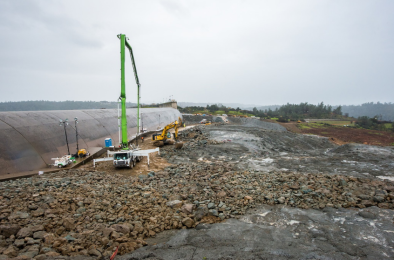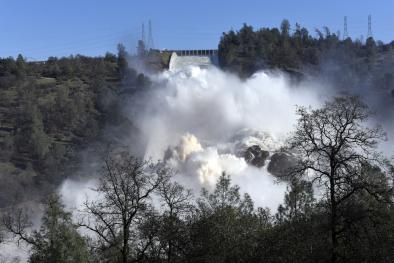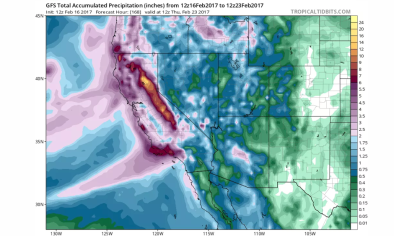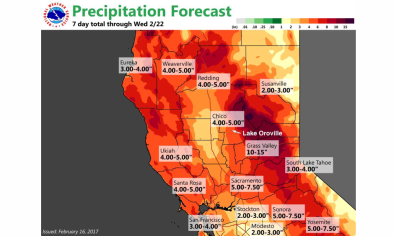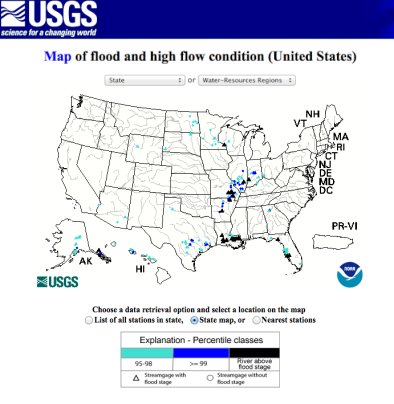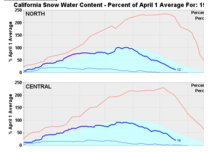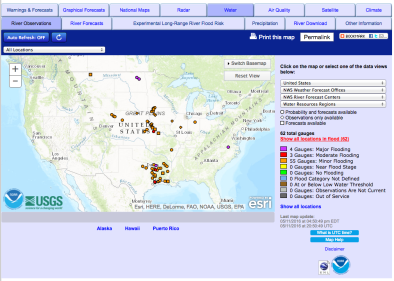Oroville Dam Spillway Overflow February 2017
A series of weather systems has delivered record-breaking heavy precipitation to California since early January 2017. On top of heavy precipitation, warm weather systems dropped rainfall in mountain regions where snow pack was forced to melt back to higher elevations and the resulting melt water joined the mountain run-off from the passing storms.
Climate change contributes to both heavy precipitation as well as warmer temperatures that prematurely melt snow pack. The combination of heavy precipitation and snow-pack melt has driven the state from drought to flood. Natural climate variability in California is extremely high. Both drought and flood are part of the natural climate pattern. And climate change contributes to both. As California swings between drought and flood climate change helps push the pendulum out to either extreme, furthering weather whiplash.
An attribution study reports that runoff in the watershed supplying the Oroville dam during the peak precipitation immediately prior to the dam failure was one-third greater than it otherwise would have been were it not for global warming.[1]
Infrastructure, such as the Oroville Dam, is designed to withstand the extreme weather seen in the historical record. As extreme weather becomes more severe than weather of the past, thresholds can be crossed and infrastructure is threatened with collapse.
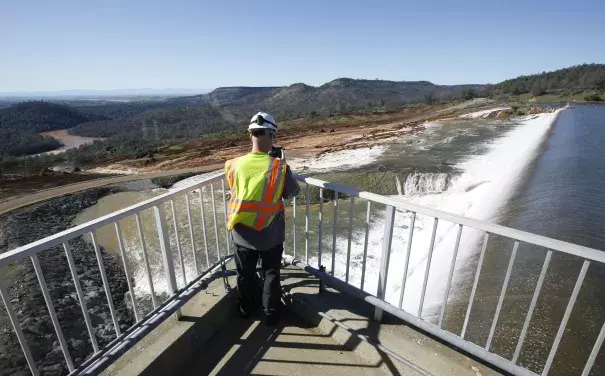
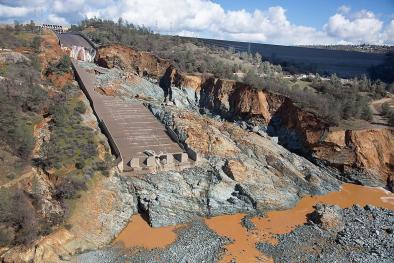
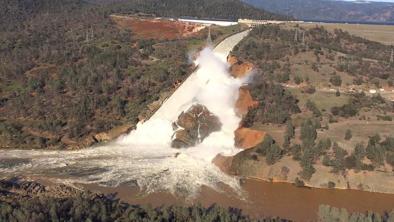
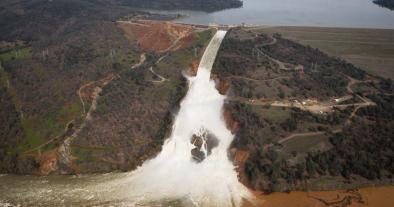

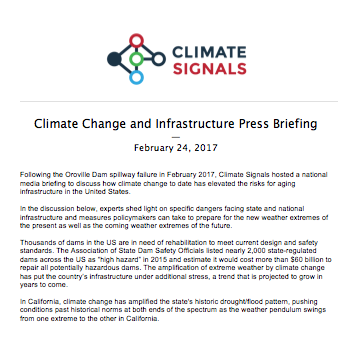
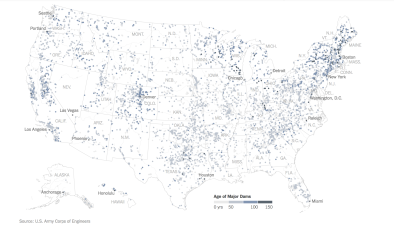
Climate science at a glance
- Extreme precipitation is increasing. This is a global trend that has been clearly documented and firmly attributed to global warming. A warming atmosphere can hold more water vapor. And like a larger bucket that can hold and dump more water, a warmer atmosphere concentrates precipitation into events that are more extreme.
- Warming temperatures prematurely melt snow pack and convert snowfall to rainfall (which also furthers snow pack melt), all contribute to run-off and increasing flood risk.
- Infrastructure is being damaged by heavy downpours and damages are projected to increase with continued climate change.[1]
- Climate change contributes to both flood and drought in California, further polarizing climate conditions, i.e. weather whiplash.
- Runoff in the watershed supplying the Oroville Dam during the peak precipitation immediately prior to the dam failure was one-third greater than it otherwise would have been were it not for global warming.[2]
- Historical warming reduced 2016–2017 Sierra Nevada snow water equivalent by 20 percent while increasing early‐season runoff by 30 percent. A smaller snow‐to‐rain ratio, as opposed to increased snowmelt, is found to be the primary mechanism of temperature impacts to Sierra snowpack and runoff.[2]
Relentless rainfall follows relentless drought, compromising California infrastructure
After one of the wettest starts to the rainy season on record,[3] California’s water capture and conveyance infrastructure is under considerable strain.[4] The relentless rainfall, which kicked off with two back to back atmospheric river storms the first week of January 2017, has saturated soils in northern California, causing widespread flooding of streams, smaller rivers, and coastal areas. By February, virtually all rainfall is generating rapid runoff and flowing into bodies of water that are already experiencing residually high flows.[4]
A hole appeared in the dam’s main spillway on February 7, preventing dam operators from continuing spillway releases at maximum volume. Water levels behind the dam rose rapidly, prompting state officials to begin plan for a release via overtopping of the dam at the emergency spillway. On February 11, water levels behind the dam in Lake Oroville — one of California's largest man-made lakes — were so high that water began to overtop the dam at the emergency spillway, activated for the first time since the dam was constructed in 1968.[5]
Water levels behind the Oroville Dam have risen rapidly this winter as continuous storms that brought heavy rain and snow caused the Feather River and its tributaries to swell. On February 12, the Lake Oroville reservoir was at 148 percent of the historical average.[6]
More heavy precipitation is forecast for much of California beginning February 17.
Extreme drought to extreme flood: weather whiplash hits California
Climate change in California is linked weather whiplash—a term for a rapid switch from one type of extreme weather to another, such as extreme drought-flood cycles.
A warmer atmosphere drives more extreme precipitation across all storm types, increasing the risk of flooding.[1] There has been an increase in the intensity and frequency of extreme precipitation events both globally and across the United States.[7] In California, the change in intensity is mostly focused in the northern half of the state, though some Southern California stations such as Los Angeles show changes.[8] In Sacramento, historical analysis reveals a trend toward less light rainfall and more moderate and heavy rainfall in the second half of the 20th century.[8]
Warming temperatures also convert snowfall to rainfall, which in turn can melt snow pack and increase the risk of flooding.[9][10][11] In 2015, for the first time in 120 years of record keeping, the winter average minimum temperature in the Sierra Nevada was above freezing, a key threshold for maintaining snow pack.[12] 68 percent of weather stations in California between 2,000' and 5,000' of elevation are recording a lower percentage of precipitation falling as snow during the winter snow season over the last several decades.[13]
Because winter temperatures in the Sierra Nevada mountains are often near the thawing threshold, a small difference in the temperature of passing weather systems often determines whether precipitation falls as snow or rain.[14] Rain-on-snow-producing atmospheric river storms are, on average, only 2°C warmer than others storm types that preserve snow pack.[14] Weather systems passing through California originate globally, and the average global increase in temperature has been 1°C, indicating significant risk that storms arriving in California may be warming and converting additional snow pack to mountain run-off.
Climate conditions in California are polarizing further, amplifying the flood/drought pattern that has repeatedly visited the state over the last century.[15][16] Overall basin dryness has increased, due to warming temperatures which dry out soils and amplifies drought conditions. This in turn decreases flood risk.[17] However at the same time, as rainfall is concentrated into extreme precipitation events and as increasingly less precipitation falls as snow, flood risk increases.[7] These trends combine to drive weather toward extremes at either end of the drought/flood spectrum.
Climate models project that the intensity and duration of atmospheric rivers increase in the Golden State in a warming climate, with the most intense atmospheric river storms becoming more frequent.[18][19][20] In addition, the AR season is prolonged and landfall locations change.[21] In looking at recent observations, a detectable signal has not yet arisen out of the background noise made up by natural variability to confirm that climate change is already affecting the frequency of atmospheric rivers storms in California.
Infrastructure was designed for the climate of the past, not for the rapidly changing climate of the present
Thousands of dams in the US are in need of rehabilitation to meet current design and safety standards.[22] Flooding along rivers, lakes, and in cities following heavy downpours, prolonged rains, and rapid melting of snowpack is exceeding the limits of flood protection infrastructure designed for historical conditions.[1]
In 2005, a trio of environmental groups filed a complaint with the Federal Energy Regulatory Commission, saying the Oroville Dam did not meet modern safety standards, because, in the event of extreme rain and flooding, fast-rising water would overwhelm the main concrete spillway, then flow down the emergency spillway, and that could cause heavy erosion that would create flooding for communities downstream, possibly causing a failure.[23]
Related Content
